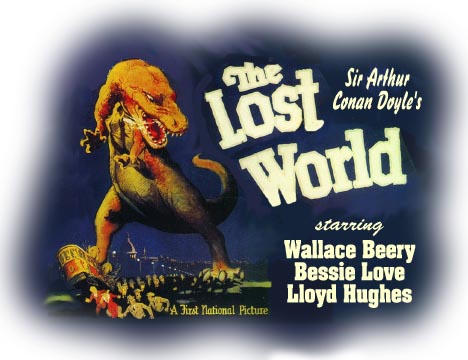

The learned professors are delightedly trailing a brontosaurus, observing its habits, when it meets an enemy. Another fight occurs, ending with the brontosaurus falling off the plateau into the muddy swamp below. Then a volcanic eruption starts, and the plateau is swept by fire. Paula and Sir John anxiously await in the caves the return of Malone and the professors. The fires die down at dawn, and the three are safe. From below, the monkey is sent up carrying the rope ladder. At last he reaches the cave, and the ladder is secured. One by one the travelers descend as they are watched evilly by the apeman.
Malone is the last down, and when he is halfway, the apeman gets to the ladder and begins hauling it up. A bullet from Sir John saves Malone who reaches the plain below in safety. The party is then met by some members of a Brazilian Geodetic Survey who had been attracted by the eruption on the plateau. They resolve to take the brontosaurus with them that lies imprisoned in the mud nearby.
Back in London Challenger is addressing a still skeptical
audience when he learns that the brontosaurus escaped during disembarkation.
The streets are in an uproar as the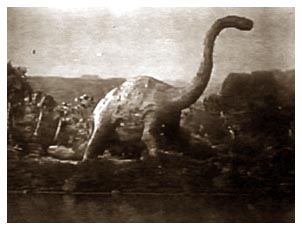 huge
beast blunders around, knocking down a house and a monument and
finally straying on to Tower Bridge. When the North bascule collapses,
he is thrown into the river. Paula and Malone drive off - Challenger
sits sadly on a parapet, triumphantly vindicated but bemoaning
the loss of his brontosaurus.
huge
beast blunders around, knocking down a house and a monument and
finally straying on to Tower Bridge. When the North bascule collapses,
he is thrown into the river. Paula and Malone drive off - Challenger
sits sadly on a parapet, triumphantly vindicated but bemoaning
the loss of his brontosaurus.
Typically American Film
Construction
Consideration of this treatment-synopsis will at once
impress the reader with its typically American film construction
- rather slow opening, development of main narrative kept at sustained
pitch of interest and excitement and several high spots, and hectic
climax followed by brief rounding-off of the romantic angle. "The
Lost World" is essentially a super adventure story, and all
concerned in the production showed exceptionally good taste in
the avoidance of lurid sensationalism. The following extracts
from the trade review in "The Bioscope" of 5/3/1925
are of interest. . .
"Despite its boldly imaginative character, the story is made as convincing as possible by the soberly restrained style in which it is narrated and the numberless realistic details . . . It was a mistake to introduce the Tarzanesque man-ape played by Bull Montana who is too palpably a human being. In all other respects, however, the atmosphere of these most difficult episodes is as convincing as it is weird and thrilling.
"The whole production is, of course, primarily a triumph of studio-craft, and it is probable that chief honours for its success should be awarded to Willis H. O'Brien, the research and technical director. The prehistoric monsters (which are the leading feature, if not the raison-d'etre of the production) are marvels of ingenuity, both in design and in the method of animation . . .
"Quite the outstanding performance is that of Wallace Beery as the formidable bearded professor-explorer . . . The scenes in London . . . are for the most part cleverly done . . . The electrical advertisement of 'Sea Hawk' on the façade of the London Pavilion might, however, have been omitted."
It is amusing to note "The Bioscope's" frown at this nonchalantly introduced advertisement of "The Sea Hawk" which was also, of course, a First National Picture.
The lead titles are imposing, set on a background of the
plateau. The players' names are prefixed with "Mr."
or "Miss," a practice that was common in 1919 but rare
later. The 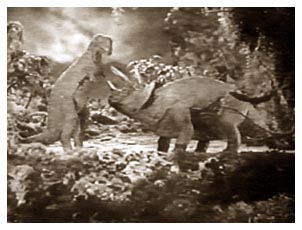 action starts in the newspaper
office where, as in the book, Challenger is indirectly introduced
in conversation. Malone, asking for a dangerous job, knocks over
an ink bottle, mops ink with his handkerchief, retreats in confusion,
trips on a banana skin, crashes into the chief's office, and gets
asked if he has been interviewing Challenger. Thus is Challenger
impressed on the audience, but at the expense of rather inept
by-play, out of keeping with Malone's character. The sequence
is handled in the characteristic mid-shot-cum-semi-close-up routine
and is printed on amber stock, the conventional and appropriate
tint for such scenes.
action starts in the newspaper
office where, as in the book, Challenger is indirectly introduced
in conversation. Malone, asking for a dangerous job, knocks over
an ink bottle, mops ink with his handkerchief, retreats in confusion,
trips on a banana skin, crashes into the chief's office, and gets
asked if he has been interviewing Challenger. Thus is Challenger
impressed on the audience, but at the expense of rather inept
by-play, out of keeping with Malone's character. The sequence
is handled in the characteristic mid-shot-cum-semi-close-up routine
and is printed on amber stock, the conventional and appropriate
tint for such scenes.
Expressive Introduction
In a huge interior at the zoological hall, Sir John
is introduced standing beside a reconstructed brontosaurus. Crowds,
in spacious long-shot, are shown trickling up into the lecture
room while in lengthy dialogue titles. Malone and Sir John discuss
the possibilities of Challenger's claims. They proceed to the
lecture: fade-out.
Fade-in L.S. The lecture room, facing the platform:
C-M.S. One man on the platform, speaking.
C-M.S. Malone and Sir John, who says . . .
TITLE "That's Professor Summerlee, the eminent coleopterist."
C-M.S. (as above) Summerlee continues speaking . . .
TITLE (introducing, with reserves, Challenger)
L.S. Audience reaction: students cheer and shout
C-M.S. Challenger looks at his audience
Thus is Challenger introduced. Frequent shots of well-directed
audience reaction are intercut with his remarks. He gets his committee
of Sir John and Summerlee, but Malone . . .
C-M.S. stammers
TITLE "I - I'm a-a-er-a reporter, sir. London Record Journal."
M-L.S. Challenger charges off the platform and . . .
L.S. . . . chases Malone down the gangway . . .
L.S. (exterior, night, fog) Malone sprints out, away around a
corner: Challenger appears, followed by a crowd - cannot see Malone
. . .
This is good, slick cutting, particularly from title to mid-long shot of Challenger's enraged reaction. Challenger proceeds home by taxi, Malone having climbed on behind. Arriving home, Malone watches Challenger enter his front door in a very nicely lit shot of the studio re-constructed Kensington house. As the door opens, light from the hall streams brightly out. Depth and perspective are superbly achieved.
Malone climbs in at the window. Challenger flings him out. A policeman and passers-by collect. Malone takes the blame, explains friendship with Sir John, and they enter the house. Amber stock continues throughout. The fog - indispensable in Hollywood-conceived London night exteriors - is excellently done (probably by means of the evil-smelling smoke so happily produced by the props for these occasions) except for the big long shot which appears to be a gauze shot.
The Director Errs. .
.
The waistless fashion of 1925 detracts from the effectiveness
of Bessie Love's first appearance as Paula White. She is shown
in close mid-shot at the door, then in long shot she walks into
the room for introduction to Malone. After the discussion, relieved
by inserted detail close-ups of drawings in Maple White's logbook
that give a pleasant foretaste of thrills to come, the party disperses.
Sir John lingers for a sentimental word with Paula who reacts
with the stock gesture of inclining her head to one side and smiling
ever so slightly. She then holds her father's logbook over her
heart and stands looking into the distance. Slow fade-out.
These are not the actions of a trained secretary and experienced explorer, and the director has erred in allowing a wave of sentimentality to flow across his picture at this point. However, he quickly returns to business by fading in on a close-up of the Record-Journal headline quoting the position of the party - and at once we join them in a journey up some tributary of the Amazon through tangled foliage wherein lurk sloths, pumas, snakes and others shown in close-ups intercut so that convincing realism is established.
Fading out on the river journey, we fade in on a long shot of the plateau and mix to long shot of camp pitched under the huge cliffs. Position is explained by a detail shot of the letter Malone is typing to his chief. A lull of comedy is provided by two spectacle bears watched by Sir John and Paula. Then, unexpectedly and heightened in effect by contrast, we see a sinister apeman on the cliffs. He prepares to dislodge a huge boulder onto the party below who are discussing how they will climb the pinnacle at the end of the plateau the next day and make a bridge across by felling the second tree - the stump of the first, felled by Maple White, is pointed out. Thus is interest excited and maintained - the stump proving the accuracy of Challenger's claims.
Then the boulder crashes down. Momentary confusion reigns. Then all eyes turn to the plateau and pinnacle - and in long shot a huge bird flies, circles, perches on the pinnacle. Beside its mammoth size the tree seems a mere sapling. Challenger is transformed with interest and excitement. Next morning, the tree felling is shown in a vast long shot from the camp below where Austin and Zambo watch. Then cut to mid-long shot up on the pinnacle. The tree starts falling. Cut (on action, unexpected but really excellent) to the continuation of the fall taken from the camp - and there is the bridge. Taking their cue from the book (Chapter 9) which reads:
"Summerlee was the second . . . I came next, and tried hard not to look down into the horrible gulf over which I was passing . . ."
The adaptors dramatized the crossing thus: (Malone and Challenger
have crossed and there is a rope over, held at each end):
M.S. Paula starts across . . .
L.S. (from camp below) She proceeds, slowly . . .
C-M.S. The apeman is watching . . .
L.S. (as above) Paula proceeds, hesitates near the centre . .
.
M.S. (high angle) her eyes flicker downwards - she sways . . .
C.S. (low angle) Sir John indicates she must look upwards.
M.S. (high angle) She still wavers . . .
C.S. Malone frantically shouts, "Look upwards."
L.S. (from camp below) She gets over . . .
The excellent arrangement of this sequence speaks for itself. Particularly admirable are the matching of shots taken from such enormously separated viewpoints - and the acting of Bessie Love, who manages to look as if she really had an attack of vertigo. Then again comes comedy relief as Jocko, the monkey, runs back on seeing the brontosaurus who dislodges the tree. Throughout this sequence and what follows - complex double-exposures, animation, scale effects and models are continually on the screen. The best praise for their remarkable accomplishment is to point out how unnoticeable they are.
Clever Superimposition
Frequently the explorers are shown in the same picture
as one or more of the prehistoric monsters. Also, moving clouds,
foliage, or water is in most cases to be seen, indicating superimposition.
From the monsters, the "harmless-unless-he-steps-on-us"
brontosaurus and the "vicious pest" allosaurus are singled
out as the hero and villain, respectively.
At night, an allosaurus attacks the camp in a thrilling
sequence of crisp action, the monster appearing with astonishing
realism. The apeman hovers menacingly near and is shot 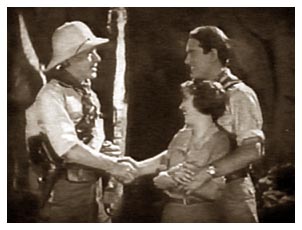 in
the arm. He is later shown in a curiously well-composed mid-shot
bathing the wound.
in
the arm. He is later shown in a curiously well-composed mid-shot
bathing the wound.
In the caves, Sir John finds a skeleton and watch bearing the initials M.W. - shown in detail close-up as he rubs them clean. Opening the back, he exposes a miniature of Paula. A nice touch. In another part of the caves, Paula and Malone are together . . . and thus, true to type, Lewis Stone finds them and silently renounces with a quiet smile his own love of Paula. This sequence is sensitively handled. So is the next cave sequence when, Malone having gone after the professors, Sir John shows Paula the watch. Photographed in harsh relief, Paula is pathetically drawn with sorrow, and Sir John stands, comforting her. Then comes the amazing brontosaurus-allosaurus fight, ending with the former crashing off the plateau into the muddy swamp of the plain.
Then suddenly, the screen flashes with scarlet as a volcanic eruption starts. Paula and Sir John await the missing professors in a finely composed long shot in the cave. The red tinting being correctly carried through so that the effect of the lurid eruption fire pervades the screen. In a superb sequence, cut with high-pitched rhythm in the best action-tradition of the American screen, Malone frantically chases after the professors while lava boils evilly, flames flash round tall trees in an inferno, the great monsters flee in panic, and more fire pours from the volcano. The volcano is portrayed diversely by library footage (in one shot the frame-line drops, denoting pre-1920 masking) and by a rather crude model held just too long. The lava, filmed in slow panning shots, is extremely convincing and sinister.
Then, in very slow fade-in on a long shot over the plateau, the dawn breaks. Smoke and steam still rise, and many monsters roam about, some feasting on remains. The change back from red tinting emphasises the effect of the dawn light. Below, Jocko is sent up with the rope. The height of the cave is established in a remote long shot seen earlier in the film but now repeated for emphasis. Jocko reaches the last height after twice falling back - a good moment of suspense. Meanwhile, the professors have reached the cave and, from another part of the caves, the apeman descends. . . intercutting creates suspense, as well as permitting the process of climbing down the ladder to be condensed.
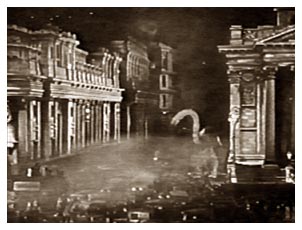 Finally, Malone gets on the ladder.
As he disappears from sight there emerges, slowly materializing
from the dark depths of the cave, the threatening form of the
apeman spurred on by a grimacing chimpanzee whose clapping and
grinning emphasise the danger to Malone. He hauls up the ladder.
In a long shot taken facing the plateau, Malone is shown swinging
dangerously. Then Sir John fires. The ladder is released. Malone
is safe. Cutting back to the stirring form of the brontosaurus
in the mud permits further condensation of the inherently slow
business of the climb, of which in fact only a minute portion
is actually shown. Then comes Major Hibberd, a most welcome figure,
and a suggestion that the monster should go to London.
Finally, Malone gets on the ladder.
As he disappears from sight there emerges, slowly materializing
from the dark depths of the cave, the threatening form of the
apeman spurred on by a grimacing chimpanzee whose clapping and
grinning emphasise the danger to Malone. He hauls up the ladder.
In a long shot taken facing the plateau, Malone is shown swinging
dangerously. Then Sir John fires. The ladder is released. Malone
is safe. Cutting back to the stirring form of the brontosaurus
in the mud permits further condensation of the inherently slow
business of the climb, of which in fact only a minute portion
is actually shown. Then comes Major Hibberd, a most welcome figure,
and a suggestion that the monster should go to London.
In London, Challenger addresses his audience again. By telephone
from panic-stricken Malone he learns of the monster's escape.
The night street scenes are well contrived. In long shot, the
crowd scrambles away as the brontosaurus lumbers down a street.
Then come mid-shots - details of the crowd, as well as details
such as the sweep of the monster's tail tumbling several men.
There is one, isolated, incredibly bad shot, given a cartoon appearance
by having been touched up. Its presence is a mystery since its
removal does nothing but good. Then comes a flash of genius:
C-M.S. A man looks in horror . . .
M.S. A woman with a child stumbling in the road . . .
M.S. The brontosaurus looks down at them . . .
L.S. . . . his enormous foot over them - the man dashes up . .
.
M.S. . . . supports the woman, cocks revolver, fires as the foot
is on the point of crushing them . . .
L.S. The monster rears up in pain - the man drags the woman to
safety
The second and fifth shots are dramatically arranged with stark black backgrounds and vividly bright foregrounds in a very strong composition. About the final accident, in a model shot of Tower Bridge that is beyond praise, there is somehow a tinge of regret. One feels for Challenger as he watches his monster flounder to death in the river. That this feeling can exist for a studio-manufactured monster and a sublimely arrogant, bearded professor only goes once more to show what indescribable magnetism can come from the cinema screen when its art and technique are thoughtfully exploited.
A brief summary of the production phase follows:
Scenario:
It is clear that a "ready-to-shoot" script
was handed to the director, and such errors as Paula's nervous
looks at the snake on the river journey, ludicrous in a hardened
explorer, have been slavishly followed. From the narrative and
entertainment aspects, the scenario is excellently constructed
to a routine formula. The adaptation from the book, even if 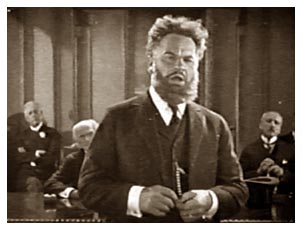 disliked, had at least the indisputable merit
of cutting much "dead" action - such as the tour round
the plateau before the ascent, which even the ultra-purists would
hardly desire to retain.
disliked, had at least the indisputable merit
of cutting much "dead" action - such as the tour round
the plateau before the ascent, which even the ultra-purists would
hardly desire to retain.
Direction:
It appears that, working from a rigid scenario with
an imposing cast plus the mechanical monsters, Harry Hoyt's style
was cramped. One looks in vain for nice touches in the Capra or
Lubitsch manner. Unaffected directness is the keynote, and, since
he made no subsequent film of particular note, he could only be
classed as a competent but uninspired craftsman.
Acting:
Wallace Beery graduated from one-reel comedies to big
parts such as the crooked sea captain in "The Sea Hawk,"
and the sinister victim of the mad doctor, Lon Chaney, in "A
Blind Bargain" (1922). His rendering of Challenger remains
a triumph. Later he did comedy-team work with Raymond Hatton (e.g.,
"Behind the Front"), then alternate Marie Dressler comedy-dramas
and routine heavies in talkies, till now he has joined the Laughton-Arliss
ranks. He no longer acts. He merely indicates how his characters
would have behaved if they'd been Wallace Beery.
Bessie Love will be remembered for many silent leads, always competently handled. She was also in the "Hollywood Revue of 1929," all-star MGM talkie released in April 1930, and reappeared in "Journey Together" (1945).
Lewis Stone has always specialized in the gentleman who has to give up the girl to a younger man round about reel four. Even with this typing handicap, he gets away with a sincere and convincing performance.
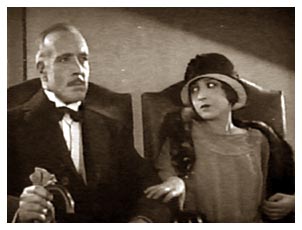 Lloyd Hughes appeared as the rascally
brother in "The Sea Hawk," but was in general a stock
leading man and is still appearing. The supporting parts play
with that effective routine that has always been an admirable
feature of the American screen. Bull Montana, cruelly handicapped
by looking like Hyde, does manage to make something of the apeman.
It would have been wiser to heed Conan Doyle's description . .
. "A long, whitish face . . . the nose flattened, and the
lower jaw projecting with a bristle of coarse whiskers round the
chin." The monkey and chimpanzee also turn in grand performances.
Lloyd Hughes appeared as the rascally
brother in "The Sea Hawk," but was in general a stock
leading man and is still appearing. The supporting parts play
with that effective routine that has always been an admirable
feature of the American screen. Bull Montana, cruelly handicapped
by looking like Hyde, does manage to make something of the apeman.
It would have been wiser to heed Conan Doyle's description . .
. "A long, whitish face . . . the nose flattened, and the
lower jaw projecting with a bristle of coarse whiskers round the
chin." The monkey and chimpanzee also turn in grand performances.
Photography:
Arthur Edeson worked on Douglas Fairbanks' "The
Thief of Bagdad" (1924) that was full of trick effects, some
extremely elaborate. The photography of "The Lost World"
conforms to the characteristic technical competence of the American
cinema, being an absolutely clear-cut record of the action, whether
real or faked. There are only about half a dozen shots that show
any signs of considered composition. There is no thoughtful grouping
of the players. There is nothing but 100 percent practical and
efficient realism, admirably achieved but lacking in artistic
inspiration. The camera is wholly an objective recorder.
Fred Jackman was recalled from directing to supervise some of the trick photography. His previous film work had included photographing Mack Sennett comedies and directing Ruth Roland serials.
Design:
Both the model and the full-size sets, interior and
exterior, are notable for their realism, attention to detail,
and general effectiveness. They are lit "all over" every
corner being revealed at the possible expense of the audience's
attention wandering from the action.
Montage:
This is uninspired except occasionally, shot lengths
being, for the most part, governed entirely by the action content
regardless of the rhythm that can be produced by timing the lengths
carefully. However, a dramatic tempo is successfully worked up
in the volcanic eruption sequence.
General:
"The Lost World" still stands as a monument
of film technique on the studio reconstruction side. Its successor,
the talkie "King Kong," though more stupendous and too
much more sensational, was handicapped by having a manufactured
story and a ludicrous climax. The producers gave in to this by
making its sequel, "Son of Kong," an unashamed comedy.
In seeing the condensed version available, it is necessary to make due allowance for a certain geographical confusion about the cave situation on the plateau, as well as occasional continuity jumps, and the inevitable loss in characterization, particularly the complete loss of Alma Bennett as Gladys. Such pieces of dramatic licence as the smartly groomed appearance of the explorers after being marooned on the plateau should be conceded in an adventure tale. One would conclude by mentioning that the film has never departed the spirit of Sir Arthur Conan Doyle's rather charming dedication of his book . . .
NOTE: An almost full-length version of "The Lost World"
was restored by Eastman House, but not released on DVD. A separate,
almost-complete version by David Shepard was released on DVD by
Image Entertainment in New York. - Kevin Brownlow